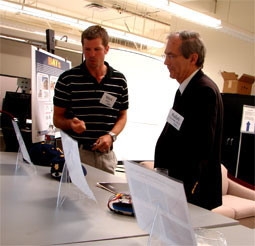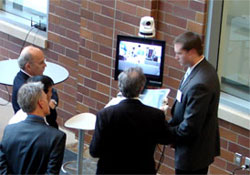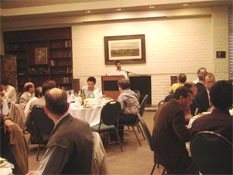Examining the Technology
|
Irvine, Calif., June 12, 2009 -- Healthcare IT is a field that’s growing rapidly, more so with the advent of smart devices, wireless sensors and high-speed, secure networks that make the sharing of information much easier.
Given the numerous telecommunication and IT strengths at UCI, Calit2-affiliated researchers are developing and testing prototypes for healthcare applications. In part two of a growing alliance, a group of UCI physicians was invited to examine the technology tools that will advance their medical practice.
With UCI developing a telemedicine training facility and opening a new hospital, collaboration between Calit2 and the School of Medicine has been percolating. Earlier this spring, Ralph Clayman, school of medicine acting dean, hosted a brainstorming-and-dinner session at the medical center in Orange. A group of Calit2 researchers shared with physicians what healthcare-related technologies they were working on, and in turn, the physicians explained what needs they had and the types of IT-solutions they wished for.
The initial gathering stimulated much discussion, break-out conversations and potential new research partnerships.
“The meeting was a really great start for future collaborations. There was a lot of energy and enthusiasm,” said G.P. Li, Calit2 Irvine director.
|
||||
As a result, participants decided it was necessary to take a field trip to Calit2.
Last week, Li facilitated an open house with research demonstrations in various labs throughout the building’s first and second floors. The medical group had an opportunity to experience in person what they had discussed a few months earlier with the researchers.
Among the projects demonstrated was Calit2’s new Telios (Telepresence Interactive Operating System) software package that transforms computing devices into user-friendly, real-time telemedicine tools. The team developing Telios is getting set to deploy units in several medical settings and many physicians were impressed by its broad capabilities.
“I was amazed by the sophistication of the technology available, and by the innovative ideas for its use,” said Anne Tournay, associate clinical professor in pediatrics. “The home telemedicine system was of particular interest, as it was exactly what I've been looking for to use in a research proposal.”
The open house was followed by dinner where Li invited each person in attendance to give some brief remarks on what s/he saw in the demonstrations and what interested them the most.
“All I can say is this has been long overdue,” Clayman enthusiastically told the group. “This has been an unbelievable evening with so many opportunities ahead….I’m pleased the School of Medicine and Calit2 are finally breaking bread together.”
Related Links



